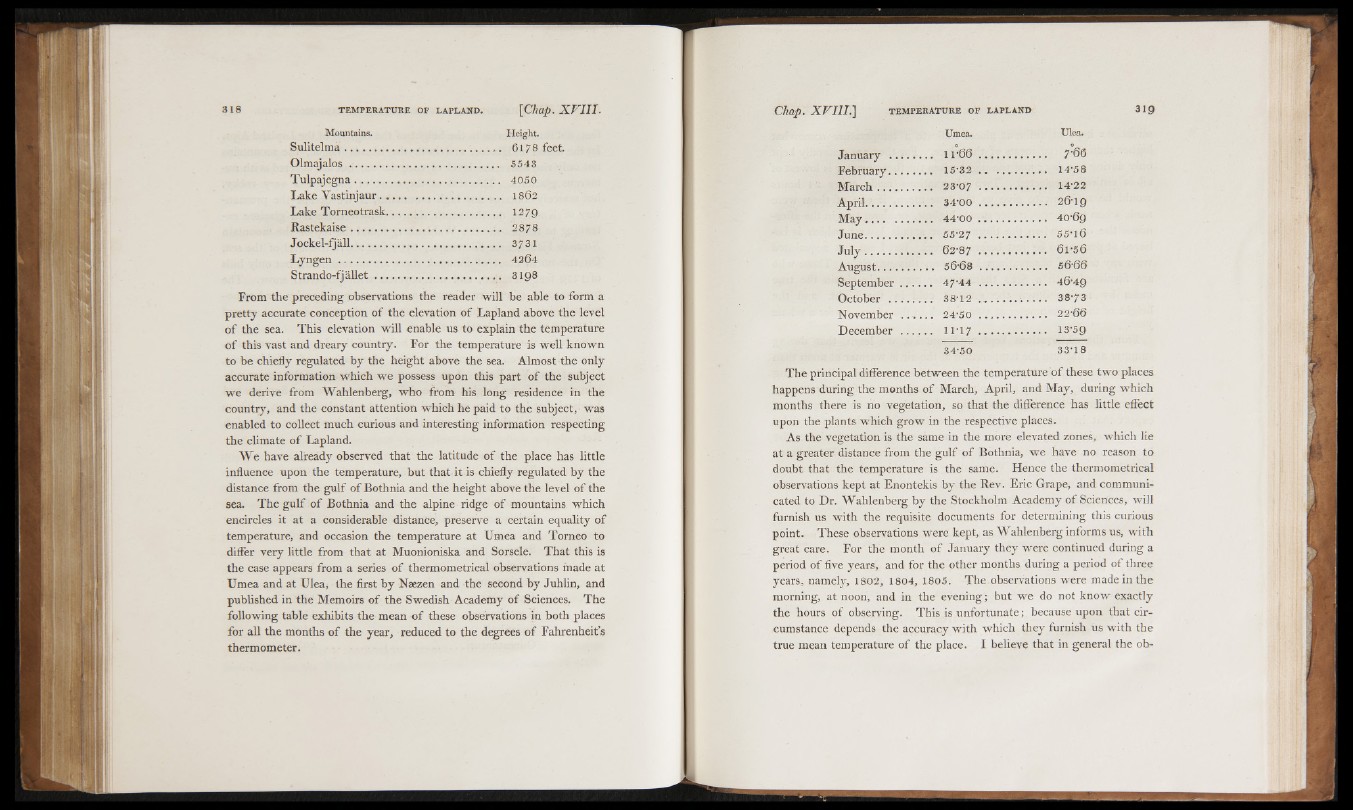
Mountains. Height.
Sulitelma................................................ 6178 feet.
Olmajalos.................................... 5543
Tulpajegna................................................ 4050
Lake Vastinjaur. . . . . .......... ................. 1862
Lake Torneotrask..................................... 1279
Rastekaise......................... „ .............. 2878
Jockel-fjaU................................................... 3731
L yn g e n ....................................................... 4264
Strando-fjallet........................................... 3 1Q8
From the preceding observations the reader will be able to form a
pretty accurate conception of the elevation of Lapland above the level
of the sea. This elevation will enable us to explain the temperature
of this vast and dreary country. For the temperature is well known
to be chiefly regulated by the height above the sea. Almost the only
accurate information which we possess upon this part o f the subject
we derive from Wahlenberg, who from his long residence in the
country, and the constant attention which he paid to the subject, was
enabled to collect much curious and interesting information respecting
the climate of Lapland.
We have already observed that the latitude of the place has little
influence upon the temperature, but that it is chiefly regulated by the
distance from the gulf of Bothnia and the height above the level of the
sea. The gulf o f Bothnia and the alpine ridge of mountains which
encircles it at a considerable distance, preserve a certain equality of
temperature, and occasion the temperature at Umea and Torneo to
differ very little from that at Muonioniska and Sorsele. That this is
the case appears from a series of thermometrical observations made at
Umea and at Ulea, the first by Nsezen and the second by Juhlin, and
published in the Memoirs o f the Swedish Academy of Sciences. The
following table exhibits the mean o f these observations in both places
for all the months o f the year, reduced to the degrees of Fahrenheit’s
thermometer.
Umea, Ulea.
January ............ i r 6 6 ........................ 7 '6 6
February............ 1 5 - 3 2 .......................... 14 -58
March.................. 23-07 14-22
April...................... 34-00 26-19
M a y . . .................. 44-00 40-69
June 55-27 55-16
J u ly 62-87 61-56
August.................. 56-68 56-66
September 47"44 ....................... 46-49
October . . . . . . . . 38-12 .. 38"73
November . . . . . . 24-50 ........................ 22-66
December ....... 1 1 - 1 7 ...................... 13-59
34-50 33-18
The principal difference between the temperature of these two places
happens during the months of March, April, and May, during which
months there is no vegetation, so that the difference has little effect
upon the plants which grow in the respective places.
As the vegetation is the same in the more elevated zones, which lie
at a greater distance from the gulf of Bothnia, we have no reason to
doubt that the temperature is the same. Hence the thermometrical
observations kept at Enontekis by the Rev. Eric Grape, and communicated
to Dr. Wahlenberg by the Stockholm Academy o f Sciences, will
furnish us with the requisite documents for determining this curious
point. These observations were kept, as Wahlenberg informs us, with
great care. For the month of January they were continued during a
period of five years, and for the other months during a period of three
years, namely, 1802, 1804, 1805. The observations were made in the
morning, at noon, and in the evening'; but we do not know exactly
the hours of observing. This is unfortunate; because upon that circumstance
depends the accuracy with which they furnish us with the
true mean temperature o f the place. I believe that in general the oh